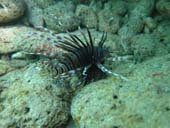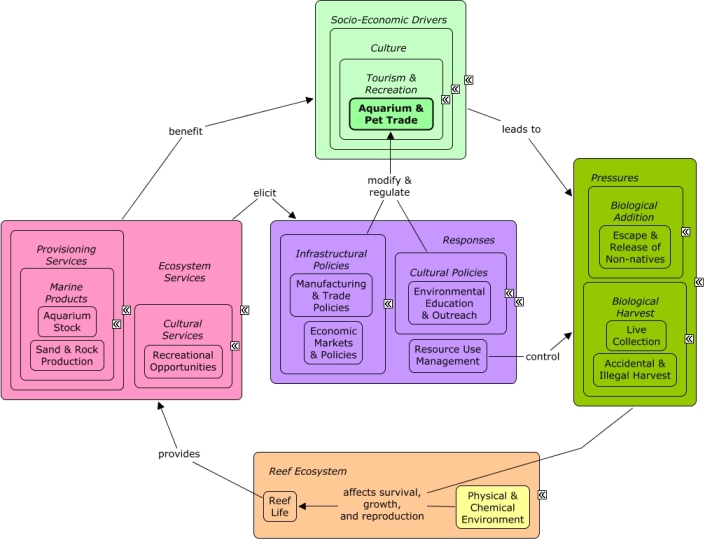ReefLink Database

Aquarium & Pet Trade
Aquarium and Pet Trade involves the preservation and exhibition of aquatic species for public view or individual hobbies, and the sale of animals (NAICS 2007).
CMap

CMap Description
The aquarium trade directly benefits from reef ecosystem services, particularly the provisioning of desirable fish and invertebrate species, sand or aragonite, and live rock that are collected for sale, as well as the aesthetic value of reefs that contribute to consumer drive to establish and maintain aquaria. Exotic aquarium species, such as lion fish, may accidentally be released into reef ecosystems where they can compete with or consume native species. Trade regulations and environmental education may reduce the sale of exotic or endangered species, and reduce the risk of accidental releases. Blast fishing and cyanide fishing are methods used to stun reef fish in order to collect them, which causes damage to the surrounding coral reefs.Citations
More than 50 citations. Click here to load.
| Citation | Year | Study Location | Study Type | Database Topics |
|---|
Management Options
| Management Option | Description | Sources | Database Topics |
|---|---|---|---|
| Economic Markets & Policy: Regulate International Trade of Reef Species | Many coral reef species are harvested internationally for a variety of markets including the aquarium trade, food, curios, jewelry and pharmaceuticals. The US is the largest importer for many of these markets. The US strictly limits extraction of stony coral and many reef species in its waters; but as a major importer and consumer of coral reef species, more actions can be taken to decrease the demand on international imports. Setting and enforcing regulations on what can be imported (such as Convention on International Trade in Endangered Species CITES) is one approach that has been taken. More information is needed, leaving room to collect trade data and assess the impacts of extraction techniques to find sustainable methods. Demand for species collected this way will be increased with greater transparency to consumers, which can be accomplished through certifications for environmentally cognoscente collectors and those using alternatives like aquaculture and coral farming. Continued participation in Asia Pacific Economic Cooperation (APEC) and International Coral Reef Initiative (ICRI) is also beneficial. | U.S. Coral Reef Task Force. 2000. International Trade in Coral and Coral Reef Species: The Role of the United States. Report of the Trade Subgroup of the International Working Group to the U.S. Coral Reef Task Force, Washington, D.C. World Resource Institute International Marinelife Alliance, editor. 1997. Sullied Seas. WRI, Washington D.C. U.S. Coral Reef Task Force. 2000. The National Action Plan to Conserve Coral Reefs. Washington, D.C. |
Accidental & Illegal Harvest; Aquaculture; Aquarium & Pet Trade; Aquarium Stock; Biological Harvest; Biological Monitoring, Mapping, & Scientific Research; Collaboration & Partnering; Coral; Corporate Responses; Cultural Policies; Designate Protected Species; Economic Markets & Policies; Environmental Education & Outreach; Invertebrate Harvest; Invertebrates; Live Collection; Manufacturing & Trade; Manufacturing & Trade Policies; Marine Products; Ornamental Jewelry & Art; Pharmaceuticals & Cosmetics; Pharmaceuticals & Cosmetics Sources; Political Pressure; Souvenir & Decorative Trade; Sponges; Stony Coral; Toxics; Wholesale & Retail Trade |
| Marine Zoning: Sanctuary Preservation Areas (SPAs) | This is a type of Marine Zoning used by the Florida Keys National Marine Sanctuary (FKNMS). SPAs focus on the protection of shallow, heavily used reefs where conflicts occur between user groups, and where concentrated visitor activity leads to resource degradation. They are designed to enhance the reproductive capabilities of renewable resources, protect areas critical for sustaining and protecting important marine species, and reduce user conflicts in high-use areas. This is accomplished through a prohibition of consumptive activities within these areas. They have been chosen based on the status of important habitat, the ability of a particular area to sustain and protect the habitat, the level of visitor use, and the degree of conflict between consumptive and non-consumptive users. The actual size and location of these zones have been determined by examination of user patterns, aerial photography, and ground-truthing of specific habitats. | NOAA Marine Sanctuary Program. 2007. Florida Keys National Marine Sanctuary revised management plan. National Ocean Service, Key West, FL. |
Accidental & Illegal Harvest; Anchoring & Vessel Grounding; Aquaculture; Aquarium & Pet Trade; Aquarium Stock; Artisanal Fishing; Beaches & Nature Parks; Biological Addition; Biological Harvest; Biological Monitoring & Restoration; Boat Movement; Boating Activities; Boating Regulations; Coastal Defense; Coastal Development; Coastal Engineering; Commercial Fisheries; Commercial Fishing Boats; Complex Habitat & Resources; Cruise Ships; Cultural Services; Decision Support; Designated Uses; Dive, Snorkeling, & Swimming Tourism; Dredging Regulations; Dredging, Draining, & Filling; Ecosystem Monitoring & Restoration; Educational & Research Opportunities; Entertainment & Accommodation Services; Environmental Monitoring & Restoration; Finfish & Shellfish Stock; Finfish Harvest; Fisheries & Hunting Policies; Fishing & Harvesting Management; Fishing Sector; Invertebrate Harvest; Landscape Changes; Large Ships; Live Collection; Marine Protected Areas; Oil & Gas Tankers; Ornamental Jewelry & Art; Permitting & Zoning; Physical Damage; Public Administration; Recreational Fishing; Recreational Opportunities; Resource Use Management; Security; Small Boats; Souvenir & Decorative Trade; Supporting Services; Tourism & Recreation; Tourism & Recreation Policies; Trampling; Travel Services & Tour Operators; Trawling & Fishing Gear Damage; Water Resources; Water Transportation |
| Resource Use Management: Prevent Introduction of Invasive Species | Preventing the introduction of invasive species involves public awareness of the invasive species, minimizing modes and prone areas for invasion, and detecting small populations for early eradication. Some common modes of terrestrial transportation include livestock and domestic animals, mowing equipment, and firewood. Clean equipment before transport to a new location. Remove soil from plants, and plant bare-root. Use high grade seed and weed free livestock feeds. Reduce opportunities for invasive plants by keeping native plant populations strong and healthy and seeding in cover crops to reduce barren soil. | Agriculture, Aquaculture, & Forestry Policies; Aquarium & Pet Trade; Ballast Discharge; Biological Addition; Construction Codes & Projects; Discharge Limitations; Environmental Education & Outreach; Escape & Release of Non-natives; Invasive Species; Landscape Conservation & Restoration; Landscaping & Household Services; Manufacturing & Trade; Transportation; Water Transportation | |
| Resource Use Management: Develop Live Collection Regulations | Live collection is often more destructive than capture of food fishes because of the destructive methods used to remove live fish and invertebrates from the reef habitat. These methods include use of cyanide and explosives. Current methods should be assessed and alternatives should be developed or collection prohibited. | World Resource Institute International Marinelife Alliance, editor. 1997. Sullied Seas. WRI, Washington D.C. |
Accidental & Illegal Harvest; Aquarium & Pet Trade; Biochemical & Genetic Resources; Biological Harvest; Biological Monitoring, Mapping, & Scientific Research; Commercial Fisheries; Contact Uses; Educational & Research Opportunities; Finfish Harvest; Fisheries & Hunting Policies; Fishing & Harvesting Management; Fishing Sector; Invertebrate Harvest; Live Collection; Marine Products; Pharmaceuticals & Cosmetics Sources; Physical Damage; Resource Use Management; Scientific Research; Sponges; Toxics; Trawling & Fishing Gear Damage; Wholesale & Retail Trade |
| Water Quality Management: Pet Waste Cleanup Ordinance & Education | In residential areas, pet waste can contributes to the large amount of nutrients and pathogens that enter the water through stormwater runoff. This is especially useful in regions such as Gu�nica, Puerto Rico where there are a lot of stray dogs. Education for pet-owners and possible ordinance would help decrease harmful pathogens reaching corals through stormwater runoff and reduce eutrophication. | Center for Watershed Protection. 2008. Guanica Bay watershed management plan. Natural Resources Conservation Service. Animal Waste Collection. Urban BMP's - Water Runoff Management Accessed 3/18/2011. Clary, J., Leisenring, M., and Jeray, J. 2010. International Stormwater Best Management Practices (BMP) Database. Pollutant Category Summary: Fecal Indicator Bacteria. Wright Water Engineers. |
Aquarium & Pet Trade; Biological Addition; Chemical Variables; Cultural Policies; Cultural Services; Culture; Cyanobacteria; Discharge Limitations; Discharges; Domestic Animal Waste; Environmental Education & Outreach; Health; Health Policies; Invasive Species; Landscaping & Household Services; Microorganisms; Nutrients; Pathogens; Shelter; Solid Waste Disposal; Stormwater Management; Waste Management; Waste Management Policies; Water; Water Resources; Water Utilities Policies; Waterborne Discharges |
Laws
| Legal Citation | Purpose of Law | Management Organization | Database Topics |
|---|---|---|---|
| Chapter 2: Protection of indigenous, endangered and threatened fish, wildlife and plants, 12 Virgin Islands Code. | Regulates activities, including scientific research, that could affect indigenous species and species considered at risk (threatened) or endangered, establishes species of special concern and habitats that should be protected, requires permits for trimming mangroves Application to Coral Reefs:It is illegal to take or posses "live rock" which is defined as dead or live coral. It is illegaal to cut all three species of mangrove trees. Forbidding the takeing of coral directly protects coral species. Not cutting mangraoves will aid in sediment control and the removal of nutrients that could enter coral reef areas. The Commission can designate habitats for listed threatened or endangered species. Legislative Actions:It is illegal to take or posses "live rock" which is defined as dead or live coral. It is illegaal to cut all three species of mangrove trees. Forbidding the takeing of coral directly protects coral species. Not cutting mangraoves will aid in sediment control and the removal of nutrients that could enter coral reef areas. The Commission can designate habitats for listed threatened or endangered species. Comments: |
US Virgin Islands, Department of Planning and Natural Resources, Division of Environmental Protection Jurisdiction: US Virgin Islands |
Accidental & Illegal Harvest; Aquarium & Pet Trade; Aquarium Stock; Biological Monitoring & Restoration; Coral; Dive, Snorkeling, & Swimming Tourism; Environmental Monitoring, Mapping, & Scientific Research; Fishing & Harvesting Management; Invertebrate Harvest; Mangroves; Ornamental Jewelry & Art; Resource Use Management; Seagrasses; Tourism & Recreation Policies |
